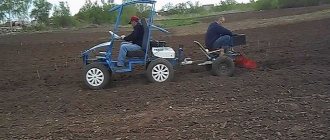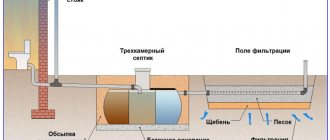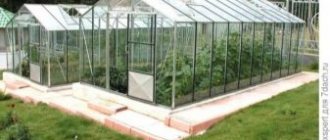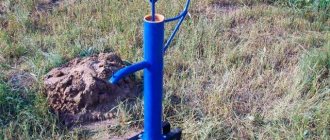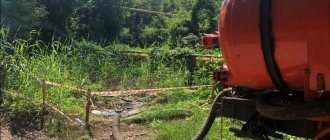What is a walk-behind tractor: the purpose of the device, principle of operation and equipment
A walk-behind tractor is a self-propelled unit designed for work in a summer cottage or in the garden of a private home. Another definition of a walk-behind tractor is often found - a single-axle tractor, which is not far from the truth, especially in relation to powerful models. The unit consists of an internal combustion engine mounted on a two-wheel axle with two handles designed to control the device. People sometimes call it a motor-plough. This definition significantly reduces the possibilities, but quite successfully reflects the essence of the unit.
The walk-behind tractor has several speeds - both forward and in reverse. The weight of the unit is about 100 kg, which contributes to the stable use of attachments. Engine power is about 6–8 liters. pp., this is quite enough to carry out gardening work. The complete set of walk-behind tractors provides for the presence of basic devices for certain works and may consist of the following parts:
- transport wheels;
- cutters for cultivation;
- axial extensions designed to widen the track.
Additional instruments can be connected to the device.
The walk-behind tractor is capable of performing almost all agricultural operations, from plowing and planting to hilling and harvesting. The unit has the ability to fold, acquiring compact dimensions suitable for transportation in a car. The capabilities of walk-behind tractors are optimally suited for work on small (up to 10 hectares) areas. Using the device makes processing the area a simple and tireless task. Even the low-power model is able to move weights of up to 400 kg. Such qualities make it popular and in demand among owners of summer cottages.
There are motor cultivators, which are sometimes considered a separate type of equipment. This is a misconception; they are walk-behind tractors with the same or slightly reduced functionality.
Accessories for walk-behind tractors
Garden tractor components may vary depending on the size and model of the tractor. Many attachments are designed for that specific tractor and are not universal or adaptable to other machines.
Some lawn mowers come with a number of accessories, including a garden plow or snow blower. If accessories are not included with the walk-behind tractor, for almost all models they are available for purchase separately.
- A snow blower or snowblower is usually an accessory that attaches to the front.
- It can have a straight or curved blade that pushes the snow in front of the walk-behind tractor.
- Some models are even tilted, like a snowplow clearing streets after a storm, so the snow is pushed to the side.
This type of garden tractor mounted plow may be available for a standard lawn mower, but clearing large amounts of snow may require a high-powered garden tractor.
Types of devices
There are several types of devices designed to treat areas of different sizes and with appropriate power. The variety of models allows site owners to choose a walk-behind tractor that is optimal in terms of power, productivity and other capabilities.
Ultralight
These units have the ability to process relatively small areas - up to 20 acres. Their working width is small, only 25–30 cm, which makes it possible to process narrow strips while moving in furrows or between rows. With power up to 3 liters. With. they weigh up to 20 kg and cope well with operations such as weeding and loosening the soil.
Two-stroke engines run on a mixture of gasoline and oil, which allows you to get maximum power in a small size
Lungs
Lightweight walk-behind tractors have a power of about 4 liters. With. and weigh up to 60 kg. Capable of processing a strip 0.5–0.9 m wide, the depth of tool immersion in the ground is 15–18 cm. They are equipped with four-stroke engines with high efficiency, more intensive fuel use and less exhaust gases.
The choice of devices with low rotation speed allows you to perform work that requires maximum power of the walk-behind tractor
Lightweight units provide a wide choice of cutter rotation speed, which can range from 100 to 350 rpm.
Average
A group of units whose weight ranges from 60–100 kg and whose power ranges from 5 to 7 hp. With. Most have two forward speeds and one reverse, designed to process areas of about 1 hectare. Increasing the weight allows for deeper penetration of the tool into the ground and reduces vibration. Medium walk-behind tractors are considered semi-professional units, although their price is significantly lower than that of professional devices, and their capabilities are superior to light machines.
All units of the semi-professional group are capable of carrying a large selection of attachments and additional equipment and are the most versatile devices
There are models with reinforced gearboxes that have an increased service life. One of the forward speeds has increased power to ensure quality digging of vegetables.
Heavy
This group of equipment is also called professional units. Motoblocks with increased operational capabilities, having a power of up to 16 hp. With. and weight exceeding 100 kg.
A large number of attachments and additional tools can be attached to heavy walk-behind tractors
These units are quite similar in quality to small tractors; they can be used as tractors for transporting goods on carts, clearing snow in winter, etc.
Class comparison
A table combining them according to their main parameters will help you visualize the capabilities and purpose of different groups of walk-behind tractors.
Correct selection of the device will extend its service life and improve the quality of work
Walk-behind tractors on the farm
Farm walk-behind tractors typically have more power, a heavier frame, and larger wheels than standard walk-behind tractors. They are designed to not only mow, hoe, seed, but also push and pull weight.
A walk-behind plow is a special attachment usually used for furrowing and clearing soil for planting or for clearing snow by pushing a snowdrift forward or to the side. The walk-behind plow is usually easy to connect using common tools.
Depending on the method of use, you need to decide on the wheels - cast, tire, or metal with mesh.
How to choose a device according to classification
Let's consider the main operating characteristics of walk-behind tractors, which determine their capabilities and degree of load during operation. Considering that the main and almost the only component of a walk-behind tractor is the engine and transmission, we will talk about them.
engine's type
Walk-behind tractors are equipped with different types of engines, depending on the purpose and power level of the device. It is customary to divide them into household, semi-professional and professional models, differing in power and resource. Both gasoline and diesel engines are used, which have their own characteristics and capabilities.
Gasoline models can be two- or four-stroke. An important quality is the low level of exhaust, which is highly valued by people who are in close proximity to the device during operation and are forced to inhale exhaust gases. There are engine models with a gearbox, power take-off shaft and other design features that increase the capabilities and performance of the walk-behind tractor.
Most modern models have a four-stroke engine, as it allows you to burn fuel more actively and get maximum benefit from it
Diesel engines are less common, mainly on medium and heavy (professional) units. They have a four-stroke configuration, are simple and reliable in operation. It is noteworthy that Chinese and European models can use interchangeable parts, this simplifies repair and operation. Most models are equipped with a manual starter. The peculiarity of the diesel engine is maximum benefit at minimal cost, which for a walk-behind tractor means high efficiency and low resource consumption of the device.
The service life of the unit directly depends on the magnitude of the loads and the volume of work performed
Volume of the tank
The capacity of the fuel tank does not determine the capabilities of the device, but characterizes its power and the approximate duration of operation without refueling. Most models are equipped with tanks with a capacity of 3.6 liters, but there are also larger devices with tanks of 8.5 and 10 liters. When choosing a device, you need to take into account the upcoming amount of work and compare it with fuel consumption. This way you will know the operating time of the walk-behind tractor without refueling and will better organize the work cycle.
Power
The power of the unit is a value that characterizes the degree of possible loads and the complexity of the work performed. It is irrational to use weak models for excessively heavy work; this will shorten the service life and increase fuel consumption. It is necessary to correctly correlate the capabilities of the device, the level of permissible forces and loads with the nature of the work in order to obtain the most efficient and durable device.
Possibility of using additional equipment
A functioning walk-behind tractor uses certain tools. Operation of the unit without attachments is pointless; the only option may be to use the device as a tractor to transport any cargo. Additional tools for the walk-behind tractor can be:
- plow, harrow;
- vegetable digger;
- lugs for hilling, hiller;
- rake;
- potato planter;
- rotary mower;
- cart;
- blade shovel;
- brush;
- weighting agent;
- snow blower;
- pump.
The units are immediately sold complete with a certain set of additional equipment, or the owner independently purchases the necessary tools as needed.
Quantity and quality of cultivated land
The type of soil determines the choice of power of the walk-behind tractor. The denser the soil and the more clay, dense or rocky inclusions it contains, the more effort will be required to cultivate it. The power of a walk-behind tractor determines its ability to process a certain strip of land in one pass. The higher the power, the wider the grip of the device. An important factor is the depth of immersion of the tool into the ground. Light models are capable of performing only superficial operations - weeding, loosening (cultivation), while heavy (professional) devices can go deeper into the bayonet of a shovel, which is important when harvesting potatoes or other root crops.
The maximum immersion depth demonstrated by the models is 38 cm
Number of speeds
Most models have two forward and one reverse speeds, which is quite enough to perform work on the site. There are units that have only one forward speed (some models of the French Cayman walk-behind tractor) or a large number of them in both directions. The power of the operating mode determines the ability to increase or decrease the speed, allowing for more flexible use of the device resource.
Dimensions and weight
These parameters are important for determining the method of storage, transportation of units, and the ability to work in the conditions of a particular site. The dimensions of the device are directly related to the power, tank capacity and design features of the model.
Average walk-behind tractor dimensions:
- length - 1740 mm (with handles);
- width - 660 mm;
- height - 1280 mm;
- width of the processed strip - 1200 mm;
- track width - 320 mm;
- wheel diameter - 320 mm.
The ground clearance of a conventional walk-behind tractor model is 140 mm, the minimum turning radius is 1100 mm, and the weight of a device with such dimensions will be 98 kg.
Availability of electric starter and other parameters
An electric starter makes it much easier to start the engine, which is very important in the cold season for physically weak (for example, elderly) people. In this regard, diesel engines, which do not have electric starters and require significant effort to start in winter, are greatly inferior. There are other features of the units, such as the presence of a power take-off shaft or gearbox, which increase the capabilities of walk-behind tractors.
Purpose of the walk-behind tractor
The walk-behind tractor can be used:
- In open ground: this is land usually planted with greens for hay, legumes, potatoes and other common crops, so it is necessary to use a large walk-behind tractor, since these crops require large attachments;
- On the farm: the device should be selected for its ability to transport large quantities of animal feed, and there should be hooks to connect to trailers carrying such loads;
In vineyards, strawberries and between rows: in this case, the walk-behind tractor must provide maneuverability, so it must be light and compact so that it can be used in very limited spaces.
Rating of popular models
There are a huge number of walk-behind tractors on the market that have different capabilities and are capable of working in conditions of varying degrees of complexity. According to information available on the Internet, the most popular among users are the units presented in the table.
Before purchasing, you should check the main components of the device, visually evaluate the quality of the coating and assembly
The listed equipment was selected based on the level of demand and the quality of user reviews, which allows us to draw conclusions about the degree of correctness of the specified data. There are many other, no less attractive models on sale that can effectively perform their tasks.
What affects the cost of plowing plots?
When you need to plow the land with a walk-behind tractor or cultivator, you want to know what the cost can be. Managers guide you by prices without seeing your site. The final payment is made by our specialists on site. They can go to the region to assess the property in advance, if required.
Several factors influence the cost:
- the purpose of plowing is for planting, for a lawn, before winter, etc.
- area and geometry of the site;
- soil composition – black soil, sand, clay;
- additional wishes of the customer.
Precautions during operation
Before starting work, you should carefully study the user manual, especially the “safety rules” section. It indicates the most important points related to working with the unit and creating one or another degree of danger for the user or surrounding people and property. The following requirements must be taken into account and fulfilled:
- the age of the person working with the walk-behind tractor must exceed 16 years;
- It is prohibited to feed the unit towards you while the engine is running;
- in the event of extraneous vibrations, noise or other abnormal changes in the operating mode, you should immediately stop working and turn off the engine;
- It is prohibited to leave a walk-behind tractor with the engine running unattended;
- when working, you should use protective gloves to reduce vibration, headphones or earplugs to reduce noise levels;
- to reduce the volume of exhaust gases in the inhaled air, you should choose the direction of movement from the leeward side (to the back);
- working in enclosed spaces requires high-quality ventilation;
- refueling is carried out with the engine stopped;
- Working near fire sources is prohibited. If a fire occurs, immediately stop work, turn off the engine and begin extinguishing the fire.
Do not operate a walk-behind tractor with protective panels, covers or fenders removed.
Compliance with these requirements will keep the health or even the life of the worker, the walk-behind tractor itself, as well as property and buildings intact.
Features of autumn and spring plowing
As strange as it may sound for a city dweller, the main plowing of the soil is carried out not in the spring, but in the fall. It is called “chill” and is intended to prepare for the winter-spring season. Deep autumn cultivation destroys harmful larvae overwintering in the soil, the earth is abundantly saturated with moisture and oxygen. Timely work significantly increases soil fertility and ensures high yields, while simultaneously reducing the damage to crops by numerous diseases.
Spring deep plowing can have the opposite effect. The combination of humidity and warm air promotes the proliferation of bacteria, fungi and other parasitic organisms in freshly dug soil. Seeds that fall into such soil will either die or grow sickly and weak.
In spring, it is preferable to harrow the top layers of soil. Thanks to the grinding of the surface, all the moisture accumulated during the autumn-winter period will be preserved in the lower layers, and the earth will also be replenished with the necessary supply of oxygen.
It is advisable to introduce manure and straw into the cultivated lands in early spring, which has been resting for at least six months. Such organic components improve the quality, increase the looseness, aerobic properties and fertility of the soil. Beginning farmers should remember that fresh, unburned manure will do more harm than good - this fertilizer can only be applied during autumn plowing.
How to install and plow a mounted plow
The main working parts of the tool are a metal ploughshare and a blade. The ploughshare carries out plowing: it cuts the upper layers of soil and directs them to the dump. And the blade wraps the earth raised by the ploughshare, crumbles it and throws it into the furrow. Thanks to this process, deep loosening of the soil occurs, during which it is saturated with oxygen and gets rid of weeds.
The picture (diagram) shows what a plowshare plow looks like, designed for plowing with a cultivator or walk-behind tractor in the garden. Different models of plowing devices may have some differences among themselves, but mostly they are all designed this way.
Before you start plowing the ground with a cultivator or walk-behind tractor, assemble a removable plow. To do this, take two bolts and use them to attach the hitch to the rack of the mounted implement. The assembled unit must be attached to the cultivator bracket, lightly fixing it, and then adjusted according to the parameters:
- plowing depth;
- blade tilt angle;
- angle of inclination of the heel (field board).
To adjust to the required plowing depth, the motor-cultivator is rolled out onto stands 12-20 cm high and placed as level as possible: the field board should be in full contact with the ground surface, and the stand should be perpendicular to it. The mounted plow is adjusted to the required position at which it will plow, and then secured with an adjuster screw and a lock nut.
To adjust the angle of the blade, tilt the cultivator to the side. To do this, remove the stand from under the right wheel (or lug), leaving only under the left one. The nuts securing the hitch to the hitch are slightly loosened, the plow is slowly turned, giving it the optimal position for plowing.
Changing the angle of the heel (field board) is carried out by rotating the adjusting screw of the cultivator hitch. If it is necessary to increase the height of the heel lift relative to the plowshare, turn the screw clockwise and vice versa. When adjusting, be sure to ensure that the distance does not exceed 3 cm, otherwise the nose of the plow, when plowing in the garden, will begin to burrow deep into the ground and worsen the traction force of the cultivator, as well as a walk-behind tractor or a walk-behind tractor. After completing the adjustment, tighten all nuts well with a wrench. You can take a more detailed look at the process of setting up a plow for plowing with Salyut, Neva and other motor cultivators in the video.
After making the above settings, the plow is completely ready for use - you can try plowing in the garden. But before you start plowing thoroughly, especially virgin soil, you perform control plowing and evaluate whether the plow is adjusted correctly, what the depth of the furrow is and the quality of the soil dump. How to properly plow with a cultivator is well shown in the video using the Neva walk-behind tractor as an example. You can also watch a video about how the heavy Zirka walk-behind tractor behaves when plowing virgin soil. Pay attention to how the plow goes deep.
When the plow is adjusted correctly, the power unit moves evenly during plowing, without jerking, without burying the “nose” of the ploughshare deep into the surface. The furrows from under the moldboard are smooth and do not “overlap” each other during plowing. If the site has hard soil, then plowing is carried out in two passes. During the first plowing, the specified shallower depth is set, and during the second, a greater depth. In the same way you need to plow virgin soil. To cultivate small areas, they mainly use a cultivator and a plowing cutter. Medium-sized plots are also cultivated with a cultivator, but with the use of a huller or a light plow, and heavy and virgin lands are cultivated with the help of a powerful motor-cultivator, for example Neva, and a mounted plow. You can develop your own plow setting technique that is suitable for your walk-behind tractor. Attaching a plow to a walk-behind tractor is not difficult.
Installation nuances
Modernization of the chassis is carried out in the case when:
- the wheelbase wears out and goes out of working order;
- it is necessary to increase the cross-country ability of the walk-behind tractor;
- the maneuverability of the unit needs to be improved.
Installation of new wheels is carried out according to the following algorithm. At the first stage, the bolts are unscrewed and the worn elements (with the disk) are removed. But before you put new wheels on the walk-behind tractor, it is important to pay attention to the arrow marked on the sidewall of the tire. It determines the direction of rotation of the wheel.
Main varieties
When deciding how to choose wheels for a walk-behind tractor, it is important to first find out what types there are. According to the classification, there are three varieties:
- pneumatic. Their design includes a rubber tire and tube;
- metal with lugs. A special feature of this wheelbase is increased cross-country ability;
- rubber. This is a one-piece design consisting of a rim and rubber.
Which option should you prefer? The choice should be made based on the operating conditions of the walk-behind tractor. For example, plowing too wet soil or a clayey area will be quite difficult if you do not use equipment equipped with metal lug wheels. Their teeth go deep into the ground, which creates additional force to ensure that the walk-behind tractor moves in the desired direction.
If the unit is used for harvesting or planting, for example, potatoes, in an area with normal soil, you can give preference to a pneumatic wheel model. If the soil is characterized by the presence of a large percentage of stones, then equipment equipped with a cast wheelbase is ideal for plowing the field. Such chassis elements demonstrate good resistance to mechanical damage. The main disadvantage of cast wheels is their heavy weight. Therefore, the latter are usually equipped with medium and heavy equipment.
Advice! To increase the performance of equipment under different weather conditions, it is recommended to purchase two types of wheels, for example, a pneumatic and a metal version with lugs. These are quick-change chassis elements, so there will be no problems with their installation.
